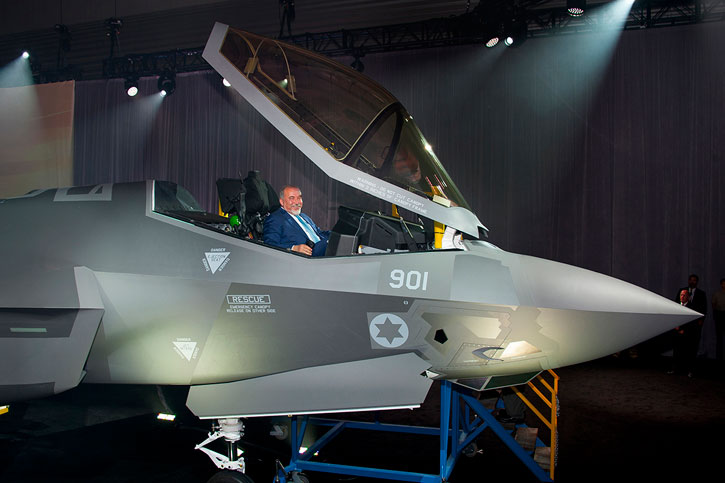Israel officially received today the first of 33 F-35A ‘ADIR’ joint strike fighters ordered for the Israel Air & Space Force (IAF). The new aircraft will be one of two F-35A fighters expected to arrive in Israel before year’s end. The advanced capabilities maintained by the new fighter jet will provide means Israel will be able to continue maintaining air dominance in the region, despite the growing threat of advanced air defenses.
Of the original nine partner countries – Australia, Canada, Denmark, Italy, the Netherlands, Norway, Turkey, the United Kingdom and the United States – six have received their first jets and had pilots and maintainers in training. Israel, one of three Foreign Military Sales (FMS) customers, received its first F-35A today. Japan, the second FMS customer, is also expected to take delivery of its first jets this year.
Suppliers in all nine of the program’s partner countries are producing F-35 components for all aircraft, not just those for their country. And in addition to the Fort Worth plant, there are two Final Assembly and Check Out (FACO) facilities outside the United States: one in Cameri, Italy, where the first jet was delivered in December 2015; another facility in Nagoya, Japan, will produce the first jets for Japan. Israeli suppliers are responsible for parts of the helmet display system and also produce the outer wings for Lockheed Martin.
Israel became the first country to select the F-35 through the United States government’s Foreign Military Sales process on Oct. 7, 2010. The Israeli Air Force gave the F-35 the Hebrew name Adir which, according to the Times of Israel, denotes awesomeness in modern Hebrew.

The aircraft rolled out today is the first of 33 F-35A fighters ordered by Israel at an average cost of US$110 million per plane. The first two will arrive in Israel in December 2016. Aside from the two that will arrive in Israel in December, six ADIRs are expected to arrive there through 2017. The Nevatim Airbase in the Negev Desert will serve as the home for the first Adir squadron. with additional six each in 2018, 2019, 2020 and 2021. Israel also received a generous industrial cooperation package worth $5.4 billion, of which Israeli industries have already received $775 million orders. The Israel Air Force is already asking for additional 17, bringing the total number ordered to 50. If this request will be approved by the Israeli government and US administration, deliveries could commence in the years 2022-2024.
The Israel Air Force is already asking for additional 17, bringing the total number ordered to 50. The Israel defense Forces’ (IDF) Chief of the General Staff, Lt. Gen. Gadi Eizenkot approved the IAF’s recommendation to raise the number of Israeli F-35 jets to 50. If this request will be approved by the Israeli government and US administration, (as part of the increase in US military aid to Israel, planned for 2019-2029), deliveries could commence in the years 2022-2024.
The Head of the IAF Chief of Air Staff, Brig. Gen. Tal Kelman, sees the first 50 jets as an intermediate phase. “We want to reach 75 jets”, Kelman said, “The Israeli F-35 is the first 5th generation fighter to arrive in the Middle East, and it will allow us to open a significant gap in our abilities when facing all of the elements in the area”. According to Kelman, the IAF is also examining the F-35B model equipped with the capacity to take off from very short runways and land vertically. “We want the first 50 jets to be A models, but beyond this, we are examining the options. The F-35B may be limited relatively to the A model regarding a number of munitions it can carry, but has other advantages that may aid us in different scenarios”.
Unique adaptations have been made to facilitate the integration of Adir with the IAF operational fleet. One of the most critical elements was the introduction of command, control and communications applications necessary to operate the new fighter within the IAF indigenous Command and Control environment. The development of this application has been completed at IAI’s labs and is now in production for the aircraft destined for Israel.
As first batch of 19 aircraft Israel is expected to receive will be the standard model operated by the US Air Force and other partner nations, it is expected to carry a limited weapon’s load comprising of two Boeing GBU-31s (JDAM) and two Lockheed Martin GBU-12s (Paveway laser guided bombs) or two Raytheon AMRAAM beyond visual range (BVR) air/air missiles. All will be carried internally.
Further adaptations expected to mature for the second batch will include the integration of certain ordnance types operated by the IAF, such as the Rafael Spice 1000 guided weapons. The more complex task is the integration of weapons carried in the internal weapon bay, thus maintaining full stealth capability of the aircraft. Other types can be taken as external stores, must also go through the lengthy integration process.




















